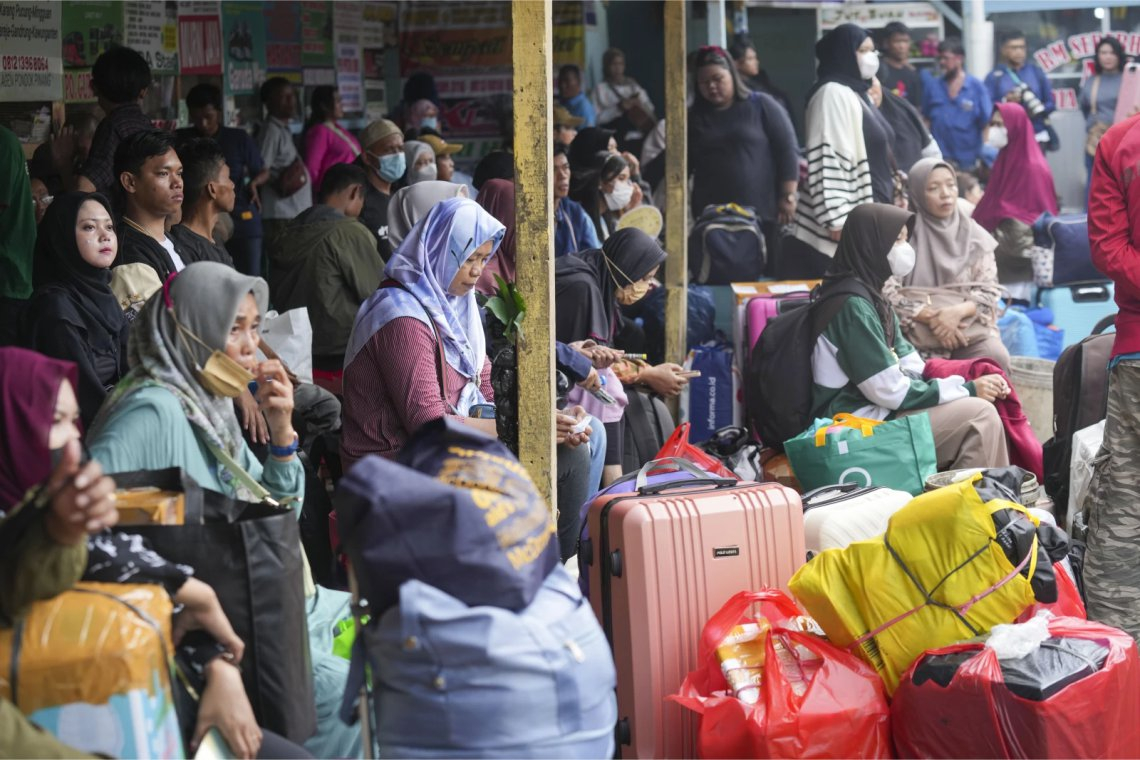Travelers in Indonesia prepare to head home for Eid (March 27, 2025). Image Source: AP Photo/Tatan Syuflana
This past week, Eid al-Fitr celebrations took place across Southeast Asia, marking the conclusion of Ramadan, the Islamic holy month. Eid was observed on March 31 and April 1 (2025), with variations depending on the sighting of the crescent moon in different countries.
Known locally as Hari Raya Aidilfitri, Lebaran, or Hari Raya Puasa, the festival is a time of spiritual reflection, renewal, and community bonding. While numerous commonalities unite Muslim communities, each Southeast Asian nation celebrates Eid uniquely, reflecting their distinct cultural identities and traditions. Despite these differences, unity, compassion, and family reunions remain at the heart of the festivities.
Across Southeast Asia, Eid is notably characterized by mass migrations to hometowns—a tradition known as balik kampung in Malaysia and Singapore, and mudik in Indonesia. This custom underscores the importance placed on family connections. Homes are meticulously prepared, communal feasts are shared, and neighbors from diverse backgrounds join in the celebrations, emphasizing hospitality and generosity as fundamental cultural values.
Brunei: Royal Hospitality
In Brunei, Eid features a distinctive royal open house tradition. At Istana Nurul Iman, the Sultan welcomes thousands of citizens and visitors, reinforcing national unity. This year, over 61,000 attended. Festivities emphasize traditional attire, formal greetings, and collective celebrations, enhancing communal harmony and national pride.

Crowds wait outside the Sultan’s palace in Brunei. Image Source: Borneo Bulletin; Ann
Indonesia: Celebratory Parades and Culinary Richness
Indonesia, the world's largest Muslim-majority nation, marks Eid—or Lebaran—with vibrant takbiran parades on the festival’s eve. Communities parade through streets chanting and drumming, creating a lively atmosphere. The diverse culinary traditions, including dishes like ketupat sayur, spicy rendang, and coto, highlight regional identities. The common greeting, "Mohon maaf lahir dan batin," emphasizes reconciliation and forgiveness.

A previous Eid celebration in Yogyakarta, Indonesia included parades and dancing. Image Source: Getty Images; Ulet Ifansasti
Malaysia: Unique Traditions and Multicultural Gatherings
Malaysia’s Hari Raya Aidilfitri celebrations vividly showcase the country's multicultural spirit through the widely practiced tradition of hosting open houses. During these events, families open their doors to friends, neighbors, and strangers alike, inviting them to partake in festive meals regardless of their cultural or religious backgrounds.
In the village of Kampung Talang, the celebrations uniquely feature the tradition of firing homemade bamboo cannons known as meriam talang. Originally devised as a means to scare away wild animals, this practice has transformed into a cherished communal event symbolizing joy, excitement, and unity.
Festive gatherings are enriched by traditional dishes such as lemang (sticky rice cooked in bamboo tubes), rich and spicy rendang (slow-cooked beef or chicken stew), and colorful assortments of kuih (traditional sweets). Additionally, the practice of distributing duit raya, money packets given by elders to children and younger family members, highlights the spirit of generosity and reinforces strong intergenerational bonds.

Malaysians in Kuala Kangsar wait to light the cannons, celebrating Eid on its eve, March 31, 2025. Image Source: REUTERS; Hasnoor Hussain
Philippines: Festivities and Culinary Heritage
In the Philippines, Eid celebrations emphasize community pride and culinary heritage, particularly in regions such as Mindanao and the Sulu archipelago. Traditional delicacies play a significant role, with dishes like dodol, a sticky rice and coconut treat, and tiyula itum, a savory black beef soup uniquely associated with the Tausug community, prominently featured during festive meals.
Eid festivals in urban areas such as Quezon City are marked by vibrant public festivities, including traditional dances, games, and competitions that encourage broad participation from the community. These events not only highlight the rich cultural traditions of Filipino Muslims but also serve as powerful tools for promoting interfaith dialogue, mutual respect, and national solidarity among the diverse population of the Philippines.

Muslims gather for Eid Al Fitr prayers in Davao City (March 31, 2025). Image Source: Philippine News Agency
Singapore: Blending Tradition with Modernity
Singapore’s Eid celebrations integrate tradition with contemporary practices. The Geylang Serai Bazaar is a bustling center of festive activity. Families dressed in coordinated outfits engage in traditional visits and increasingly use digital platforms for exchanging duit raya. These practices highlight Singapore’s balance between preserving cultural traditions and embracing modern conveniences.

Geylang Serai Bazaar during Hari Raya. Image Source: Wisma Geylang Serai
Cambodia, Laos, Thailand, and Myanmar
Eid celebrations among Muslim minority communities, such as in Cambodia, Laos, Thailand, and Myanmar, retain deep cultural significance. Cambodia’s Cham Muslims gather for communal prayers and feasts, often supported by local leaders. In Thailand, Eid celebrations include Qur’an recitations and regional dishes, strengthening cultural ties. These observances reflect resilience and identity within these smaller communities.

Gift and money-giving is a common element of Eid. (Bangkok, Thailand, March 31, 2025). Image Source: REUTERS; Chalinee Thirasupa
A Lasting Legacy
Throughout Southeast Asia, Eid al-Fitr embodies the intersection of cultural diversity and communal unity. Its enduring themes of generosity, gratitude, and reconciliation provide a lasting framework for fostering mutual respect and social cohesion beyond the festival itself.

Playing and taking family photos after Eid al-Fitr prayers at Quirino Grandstand, Philippines (March 31, 2025). Image Source: REUTERS; Lisa Marie David
REFERENCES
Associated Press. (2025, March 31). What is Eid al-Fitr and how do Muslims celebrate the Islamic holiday? AP News. https://apnews.com/article/016158da074557fe4e94f8e3d5cf24dc
Leong, M and Hussain, H. (2025, March 31). Malaysian cannon firing tradition heralds start of Eid al-Fitr. Reuters. https://www.reuters.com/world/asia-pacific/malaysian-cannon-firing-tradition-heralds-start-eid-al-fitr-2025-03-31/
Reuters Staff. (2025, March 31). Muslims around the world celebrate Eid al-Fitr. Reuters. https://www.reuters.com/pictures/pictures-eid-celebrations-around-world-2025-03-31/
Xinhua News Agency. (2025, April 3). Brunei royal palace receives over 61,000 visitors in public opening. https://english.news.cn/20250403/4b376e03f9f04c748fb4d573df8c3b5d/c.html



